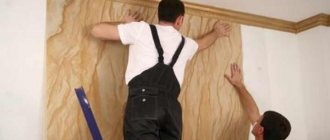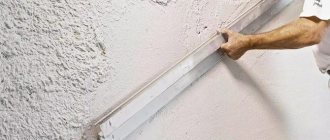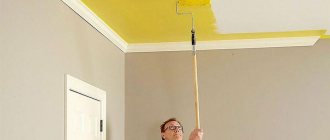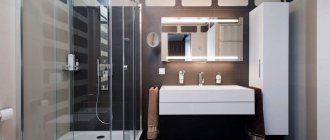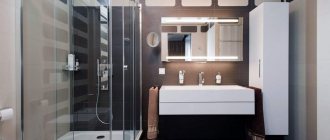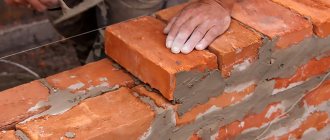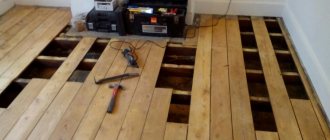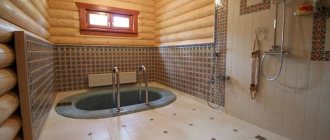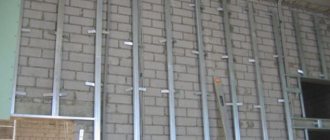This issue always causes controversy among professionals. There is no definite answer to this; each side has arguments for it, especially when it comes to rough work: plaster and screed. For finishing work, the preferred order is “walls - floors”, also known as “top to bottom”. Basic rule: when choosing a sequence of work with two finishing materials, it is better to start with the more durable one, which is easier to clean. It is better to work with fragile and easily dirty items last.
When it comes to rough work, you need to consider both sides and determine which of them is more important for a particular room.
How to protect walls
Installing a frame for a suspended ceiling is a fairly dusty process that can lead to contamination of the wall covering.
To avoid this, the walls can be covered with a protective film, and cement dust can be collected with a vacuum cleaner during drilling. The high temperatures required to install PVC ceilings can cause the wallpaper to peel away from the walls. Therefore, installation of ceiling structures should begin after the wallpaper paste has completely dried. This occurs approximately on the fourth day after pasting, subject to normal temperature conditions.
If you install ceilings yourself, the negative effects on the wall covering can be minimized by alternating the process of installing the ceiling and finishing the walls. It looks like this.
It is quite possible to repair the ceiling in an apartment yourself, and for this you do not need any special skills in construction and finishing work, but just follow the instructions. Almost every person has encountered problems such as uneven ceiling coverings, flooding, leaks and more. Naturally, you want to live in comfortable conditions and in a pleasant atmosphere, and therefore you have to think about carrying out repair and finishing work.
To repair the ceiling with your own hands, it is worth deciding what types of work exist and what features they have.
Works are divided into:
- Dry;
- Wet.
If there are minor defects on the ceiling, then major repairs are not needed and a dry renovation of the coating is sufficient. Naturally, a complete replacement of the ceiling covering will require not only investment, but also a lot of effort, patience and materials. Replacing the ceiling covering in a room is actually not difficult, but you will need to follow the instructions and completely follow each step.
There are various ways to finish the ceiling surface that are worth exploring before purchasing materials:
- Coloring;
- Paneling;
- Leveling and applying decorative plaster;
- Installation of suspended and tension structures;
- Elimination of drips;
- Repairing after a leak from the roof or removing damp parts of the cladding.
About technology
Let's start with a small lyrical digression from the directly posed question. To decide which comes first - wallpaper or suspended ceilings - it is advisable to clearly understand the technology for attaching the ceiling.
Let's look at the most popular solution - installing a PVC sheet with a harpoon.
- Along the perimeter of the room, the level of fastening of the baguette (mounting profile) is marked - a line strictly aligned along the horizon.
- Along the marked line in increments of 15-25 centimeters, mounting holes are drilled with a hammer drill.
Let us clarify: they are needed only in brick, stone and panel houses. Wooden walls allow you to secure the baguette with ordinary self-tapping screws.
- The baguette is secured with dowel screws.
- Then the canvas, pre-welded from strips of plasticized polyvinyl chloride according to the size of the room, is heated with a heat gun and stretched over the entire area of the ceiling; in this case, a specially shaped rigid edging of the canvas - a harpoon - is inserted into the groove of the baguette using a spatula and fixed in it with a simple latch.
- The baguette groove is closed with a decorative profile.
The photo shows the installation of decorative edging.
After cooling the polyvinyl chloride film, the ceiling acquires the necessary tension, leveling out the slightest folds on its surface.
Harpoonless fastening, usually used with fabric ceilings, differs only in the way the canvas is attached to the baguette. The basic sequence remains the same: marking - baguette - fastening the canvas.
Special cases
What comes first with laminate or doors
? It is impossible to cover the variety of existing materials with which modern renovations can be made. Do the floor and walls first? Where to start? In what sequence should processes be organized? Decisions on these issues often have to be made based on the specific situation. To avoid mistakes, always use a simple algorithm. When choosing between two finishing materials, first of all, use a durable one that is easy to clean. Next, work with more fragile or easily soiled ones. Here, as in medicine, the rule “Do no harm” prevails. With this in mind, you can easily organize the order of work during your home renovation.
Tsugunov Anton Valerievich
Reading time: 4 minutes
Many people are familiar with the expression “repair is a natural disaster.” To prevent the renovation of your beloved home from turning into a real “catastrophe,” you need to think through the sequence of apartment renovations and stick to it in the future. Drawing up an algorithm of actions will save you from wasting time, nerves and the family budget.
Drafting
A detailed diagram characterizing the final appearance of the room and the order of work with the smallest nuances is necessary in order to avoid an unforeseen situation when there is no electric wire connected to the place where you plan to hang the chandelier, and when installing the toilet, a protruding sewer pipe riser interferes.
Saving time at this stage and ignoring its preparation will lead to similar situations. The detailed project must have the following information:
- precise layout of the premises after finishing and construction work;
- location of communications (sewage, water supply, electricity, internet, television);
- installation sites for technological devices (toilet, boiler, washbasin, bathtub, shower, air conditioning, water and gas meters).
READ Interior wall cladding with multi-color ceramic tiles
A detailed design of the premises allows you to avoid mistakes with intermediate calculations.
In the bathroom, you need to lay tiles, where to start with the floor or walls
Why is it worth making a plasterboard suspended ceiling in the hallway?
From the walls of course
Tiles are laid starting from the floor
From the walls otherwise you will ruin the whole floor
Our master covered the walls
From the walls. You can damage your newly refinished floor by accidentally dropping the same tiles that you will be laying on the wall.
It all depends. put it under the bathtub. and behind it #8230 near the bathtub what will be the joint with the wall. from tiles. invite the master and he will tell you
The best option is from the walls. from the second row. kick out the walls, then the floor, then the first row of walls. If you do the floor first, think about the safety of the tiles, how careful you need to be so as not to damage them with a bucket of mortar or a tool. If you lay the floor first, it must be perfect, all the walls will be pushed off of it, and you will have to do a lot of trimming.
I start from the floor. I put it strictly according to the level. Then it is easier to cover the walls. Only the seams on the floor need to be grouted last, when the walls are already tiled. Floor tiles are thicker and stronger than wall tiles, so there is no need to worry about their integrity.
From the walls, or rather from the middle of the wall at a distance of 2 tiles from the floor, fasten a block (wooden) along the perimeter of the walls and start laying tiles from it upward. Every 2 rows of laid tiles should dry thoroughly. So up to the ceiling. Bottom 2 rows in the last row. Then the floor.
This is how they laid my master tiles.
First the walls (except for the very bottom row), then the floor. After this you finish the wall (bottom row). I will not describe the technology of laying tiles, since this is a separate topic.
I did it this way (for the first time in my life, without experience of such work). It turned out better than most specialists#187.
Definitely from the walls. one smart guy #187 scratched my ugly floor tile(((
It is advisable to lay the tiles from the walls, but if you level the walls and floor all at once, you can start from the floor.
Everything is different. I put the floor first, because... the bathtub is placed on it, and then the walls (the floor is covered with cardboard). A row is laid from the middle of the wall, the next cut to the bathtub and then everything else. You must put a tile baseboard on the bathtub so that water does not then get behind the bathtub.
If you have the right hands, it doesn't matter, but I lay the floor first, then cover it and make the walls. It's easier for me.
where to start laying tiles in the bathroom from the floor or walls, what to do first in the bathroom floor or walls, where to start laying tiles in the bathroom from the floor or walls, tiles in the bathroom where to start the floor or walls, where to start laying tiles from the floor or walls
Pros and cons of plastering walls after installing screed
In a situation where the screed is poured first, there are quite a few advantages:
- the laid screed allows you to install electrical wiring with the installation of boxes for sockets and switches, so as not to carry out double work: re-covering the grooves with plaster or putty mortar;
- the floor base line allows plumbers to install plumbing equipment before carrying out plastering work;
- plaster that has fallen on the floor can be easily collected from a smooth surface;
- This scheme of work practically eliminates technological interruptions - during the period of plumbing and electrical work, the base of the floor gains strength.
Minus:
- When carrying out plastering work with sawhorses or a stepladder, it is easy to damage the cement screed.
A special case is suspended ceilings
How to putty walls
Today, stretch ceilings have become extremely popular and widespread. Their installation is possible in any room, they reduce renovation time and look simply excellent. However, the installation of tensile structures makes some adjustments to the usual apartment renovation at the stage of finishing work. The rule about the direction of repairs from top to bottom, or from ceiling to floor, does not work in this case.
Most experts strongly recommend installing the canvas after finishing the walls. There is a completely reasonable explanation for this advice. Installing the ceiling after finishing the walls will protect it from the negative effects of various primers, glues and paints, which can leave indelible stains on the ceiling canvas. The ceiling material is quite expensive, so replacing it will cost much more than replacing or repairing wall coverings.
Pros and cons of screeding after plastering
When assessing the strengths and weaknesses of performing screed work after applying plaster mortar to the walls, only two points can be noted, one positive and the other negative.
Advantages of top-down work:
- there is no risk of damaging the surface of the subfloor; therefore, there is no need to take protective measures.
Flaw:
- the presence of a long technological break.
First sticking
Stages of work:
- First, you need to thoroughly clean up all construction debris and remnants of previous coatings.
- Let's evaluate the scope of work.
- If necessary, we waterproof the floor using bulk mixtures or mastics.
- We produce a rough screed using self-leveling floor technology, laying a cement mixture or adding expanded clay.
- We prime, carry out a finishing screed or lay special slabs or a dry floor.
- Self-leveling floors must be coated with a primer at each stage.
- We putty the walls with a rough layer to eliminate large-scale unevenness.
- After drying, sand and prime the surfaces.
- Finishing putty is a mandatory step. The wallpaper will stick better and stains and defects will not show through.
- Laminate flooring is laid.
- Install floor skirting boards between the wallpaper and the floor.
Full problem analysis
As for whether to do the floor or walls first, experts recommend this order. After the exact design of the room to be finished has been completed, the old partitions, floors and communications are dismantled (if required).
In the future, you need to strictly adhere to the established procedure, otherwise during finishing there is a possibility of damaging one or another element of the finished interior.
Still, it’s better to start with wall decoration
In this case, everything will depend on the type of materials used, the chosen installation technology, the amount of work, but in any case it is advisable to start with finishing the walls. Only after the installation is completed can you start working on the floors.
However, opinions differ; there is an option that it is first recommended to construct the rough work, carefully level it, and only after that proceed to finishing and laying the finishing decorative material.
Moreover, the latter method is the most optimal for a situation where repairs are carried out in one room, and not in the same apartment. In this case, the partitions are already ready, you only have to level the surface for plaster or wallpaper.
If we talk about floors, then after the horizontal relationship of their plane is checked, you can make a decision: lay the floor covering or do a major repair of the surface. What do professionals do in this case? They lay a layer of hydro- and thermal insulation, make a subfloor or pour a screed. After the layer has hardened, the walls are finished. Only after this the finishing coating is laid on the leveled floor. Watch the expert's opinion on this issue in this video:
If you decide to turn to professionals, and they claim that they will first complete the floor, and only after that the walls, ask them if the finished surface is damaged, will the craftsmen compensate for the cost of the damage caused from their own pocket? Only after such formalities have been resolved can an agreement be concluded with them.
Dismantling
Once you have everything planned, it's time to dismantle. If you started cosmetic finishing, then everything is simpler. They tore off the old wallpaper and put up new ones. But we are not here to discuss wallpaper. Our plans are more global, which means:
We dismantle old floors;
— remove the tiles that have lost their luster;
— we demolish unnecessary partitions;
— moving doorways to new places;
— we remove the painted baseboards to the side.
Now that you have gotten rid of everything unnecessary, you can move on to the next step of our plan “sequence in apartment renovation: floor, walls, ceiling.”
Preparation for renovation planning and design selection
The correctly chosen sequence of renovations in the apartment will help you complete it in a short time, without unnecessary worries. Initially, you should decide what repairs are to be made. Perhaps it will be cosmetic: limited to changing wallpaper, painting and other individual operations. If major renovations are needed, planning is essential. After all, it may touch windows, doors, walls, floors and ceilings. You might want to redesign the premises and remove the partitions.
The layout and design of premises requires careful consideration. For each room, think about what material will be needed for the walls, ceilings, and floors. You may need to replace windows or want to rearrange furniture. It’s impossible to keep everything in your head, so you need to make a plan. We measure all the rooms and make drawings on separate sheets. For each room you will need six of them: one for the floor and ceilings, four for each wall separately. On the plan, indicate the placement of windows, doors, sockets, switches, and lamps.
On each sheet, write down what materials will be used. For example, the floor in the kitchen: linoleum with insulation - 12 m2, brown color. Ceiling: 12 m2, water-based paint, white. First wall: 6.1 m 2, level - satengypsum starting, finishing, primer. Painting: water-based emulsion, peach color, colorex, primer. Replace the door with a new one, leave the trim. It is advisable to indicate how much of which material will be needed, based on consumption rates; it would be nice to indicate the price. If you do not undertake some work, but will involve a specialist, indicate this in the plan. This is only indicative planning, you can record whatever you think is necessary. A start has been made - the work has been planned.
Continuation of preparation: furniture is moved, unnecessary elements are dismantled
An ideal option if, in order to carry out renovations, it is possible to completely empty the apartment of furniture and interior elements. But, most likely, it will have to be moved to one of the rooms so that it does not interfere with work. We lay it compactly and wrap it with stretch film. Renovation begins with other rooms. When at least one room is ready, the furniture is moved there, arranging it as the rooms are ready.
The next step is to dismantle the elements that need to be replaced. If the repair is cosmetic, remove the layer of old linoleum and remove the wallpaper. During a major renovation, you may have to remove interior doors, remove partitions, change the location of doors, create special niches in the walls, remove plumbing, etc. If you are not going to change the floor, but only update it, do not forget to cover it with film so as not to damage it.
Time to remove the old windows if you are going to install new ones. After installing the windows, do not remove the protective film from them. Let it remain during the repair and protect the glass from scratches, dirt, and dust that are inevitable during repairs. If redevelopment is planned, there is a desire to start from scratch, we demolish non-load-bearing partitions.
Installation of doors and skirting boards
The installation of interior doors begins in a room with plastered, plastered walls and a finished subfloor. All “wet” work must be completed.
It is important to correctly measure the doorway and align it.
The process of installing an interior door
If the room is not finished, the door is installed without trim.
What to paint the walls or ceiling first?
When carrying out repair work on our own, we often encounter certain difficulties. For example, without knowing some professional subtleties, we may do the wrong thing. No one is immune from this. Therefore, when thinking about doing any work, it is worth getting acquainted with the peculiarities of the industry. Of course, in such cases it is quite difficult to do without professional tips. However, in the world of modern technology, it is not necessary to have a builder friend on hand, for example. It is enough to familiarize yourself with the relevant materials on the Internet.
So, many novice craftsmen or simply those who want to carry out repairs with their own hands are wondering what work to do first - the ceiling, walls or floor. And here one of the basic rules in construction comes into force regarding finishing work: all main tasks are performed from top to bottom, unlike, say, capital construction, where everything starts from the bottom.
Therefore, it is necessary to start finishing and painting surfaces, in particular, from the top. Therefore, you need to paint the ceiling first, and then the walls and everything else.
There are a lot of reasons that can be given, but the main one is the practical reason. If you first start painting the walls, and then continue with work on the ceiling, then you will not be able to do without damaging the surface of the walls. No matter how carefully you apply paint to the ceiling, there is still a high probability that drops of paint may fall on the surface of the painted walls. In this case, the qualifications of the master who performs the work are unimportant. The probability still remains, although its level is lower.
If you paint the ceiling first, and then the walls, then even if a little paint gets on the surface of the walls, it can be easily removed with a solvent or sandpaper if the paint has time to dry.
The correctness of this particular sequence of actions is confirmed by the fact that with the reverse sequence it is impossible to protect the walls from the threat of paint one hundred percent without damaging the surface layer on the walls. And if you do this, say, with masking tape, you will have to stock up on a large amount of material, as well as time to reliably paste it with protective film or paper, and then to dismantle all the protection. In any case, we end up with an unprofitable occupation in all respects.
Then the question arises, how can you protect a finished ceiling? In fact, no special methods are used other than careful and thorough painting of the walls. After all, this is the best protection. We must also not forget that paint, like any object in the world, will fall down under the force of gravity and not to the ceiling. The only thing is to take care of protecting the part of the ceiling adjacent to the walls. The same masking tape can be used for this. In addition, when painting walls, it is better to paint the area adjacent to the ceiling with a brush. Then the corners will be painted better, and the ceiling will not suffer from the roller.
Conclusion
Therefore, the answer to the question of whether to paint the ceiling or walls first is obvious in favor of the ceiling. And I just want to add that if you don’t know what to do in such a situation, use common sense. And then any construction tasks will be within your reach.
We act according to the scheme
The movement of finishing the apartment should be carried out from top to bottom: ceiling → walls → floor. This way you won’t have to worry that the part of the repair that has already been completed will be spoiled or damaged. However, there are some amendments to this course of events.
Floors. If you intend to make a new floor screed, then your path will begin from the floor, and not from the ceiling. There are two ways:
Leveling the floor using cement mixture
Fill a self-leveling self-leveling floor
The first option is cheap and labor-intensive, the second is more expensive and simpler. If possible, use the second one. You will not regret. The self-leveling floor will dry in a couple of weeks.
If the screed will not be made, follow the above scheme.
Walls. For leveling you will need plaster. The number of layers applied depends on how smooth the walls are. In turn, the time spent on leveling depends on the number of layers of plaster.
The second method is drywall. Installs easily and quickly. It is usually puttied in two layers. The first is the starting one, the second is the finishing one. It is easy to install communications and cut holes in plasterboard structures. For example, under sockets. In addition, such walls will be perfectly smooth. The only disadvantage of a plasterboard block is that it takes up part of the area.
Ceiling. The principle is the same here. Either you putty or use drywall for leveling. Pros of gypsum:
it is very easy to install lighting (spotlights, LEDs);
- ideal surface;
- the ability to make figured ceilings.
Another point that stands out from the basic scheme of “sequence in repairing floor, walls, ceiling” is a suspended ceiling. This part is best left for last. You can design boxes for suspended ceilings initially, during rough work. But you will mount it at the end.
Is the dirty work done? Start cleaning.
After installing the door frames, proceed to painting and pasting. When the cosmetics are ready, we finish by assembling the baseboards, sockets and other decor.
Finishing work - room for imagination
We carry out finishing, starting from the top - from ceilings to walls and floors. This sequence prevents damage to the repaired parts when working with others. Stretch ceilings are an exception: they are done last. If you need to make a floor, we start by leveling it with a screed. We use an economical method - a cement-sand mixture. Whenever possible, we use self-leveling floors. They are more expensive, but the result is worth it. If you are going to install a heated floor system, now is the time.
Let's start leveling the walls. The duration of work and the amount of material depend on the condition of the surfaces. You may need several layers, or you can get by with just one. The walls are leveled mainly with your own hands. Using machine leveling in an ordinary apartment is impractical. Manual alignment is performed in two ways: visual and using beacons. We align the walls that are being prepared for painting according to the beacons, which ensures better quality.
Having finished plastering, we move on to the final work - putty. Putty should be applied thoroughly to seal all uneven areas and utility lines. We finally prepare the surface for finishing. The choice of primer is important - a high-quality one will avoid problems during puttying, painting, and pasting. If you are going to install decorative elements like crown molding, do it now.
Then we move on to the wall tiles.
It is important to plan which tiles we will use on which wall. If possible, make an installation diagram on the computer or draw it on paper
This way we’ll know exactly how many tiles you’ll need and how many will have to be cut in order to wisely plan your purchase of stock. A variety of colors, patterns, finishing materials allows you to make the apartment unique. In addition to ceramic tiles, decorative mosaics, bamboo tiles, 3D elements and much more are used at this stage.
Classification of screeds
Experts distinguish several types of screeds, each of them has its own characteristics and nuances. For example, one type ensures surface leveling, while others increase thermal insulation qualities.
However, in addition to this, there is also a floating and non-floating type of screed. Let's take a closer look at each of them.
Leveling ties
Here it immediately becomes clear that the main purpose of this screed is leveling. You can also use and help to raise the height of the surface or make a slope.
Leveling and thermal insulation screeds
This type of screed, in addition to leveling, makes it possible to insulate. It is often used for slabs that are connected to the basement. Thermal insulation screed will bring greater effect if it is supplemented with a heated floor system.
And most importantly, it must be done before installing the heating elements.
Monolithic screeds
Monolithic ones can be called the most popular. In fact, this is a solid concrete or cement coating. In order to achieve this particular type of screed, several different types of concrete are used. Sand or expanded clay in such cases acts as a filler.
Floating ties
This type of screed has many differences from the above. First, the space between the subfloor and the screed is filled with a unique insulating layer. It is worth answering that it does not have the properties of sticking to the base.
Non-floating ties
As we understand from the name itself, in this case the screed is in direct contact with the base. To create this type of screed, you can use completely different materials. After all, the point is to prepare the solution and carefully level it on a previously prepared base.
How to make repairs correctly In a house without finishing, what should you do first - the floor, ceiling or walls
posted in Buying and choosing products on 04.04.2017 by
How to do repairs correctly? In a house without finishing, what should be done first - the floor, the ceiling or the walls?
- I would first do the gating for communications, then the rough walls (plaster and putty), then the rough ceiling (plasterboard, suspended systems), then the rough floor (screed, joists, plywood). Then the finished ceiling (whitewashing, painting, pasting or suspended ceiling), finished floor (laminate, parquet, linoleum, tiles) and finished walls (painting, wallpaper, fiberboard panels).
Interior doors - after the finished floor (since there must be a certain gap between the floor and the doors) but before the finished walls (since, while they are being installed, all the wallpaper will be torn and the paint will be scratched :).Windows can be done first, since after installing them the jambs still need to be plastered.
- Ceiling, walls, floor. Changes are possible depending on the selected finishing materials.
- First you need to make a project... if there is no designer, plan what will be where in the apartment, down to the bedside table and socket) and find a team of workers... this is the most difficult moment. Next... If there are no walls, put up walls. Then they install all communications, electric pipes , (or remodel communication boxes to enlarge the bathrooms) At the same time, decide whether the windows need to be replaced. Make wiring for air conditioners (this can be done immediately, and install the air conditioners themselves later).
.after the communications, the screed is poured (do you need to know in advance that you will be laying laminate, parquet, tiles?) The level of the screed depends on this. R.S A designer is needed not only to make things beautiful. It will help you save money, time - and most importantly NERVES))) - if the floor is of the laminate or carpet type, that is, clean, then this is done last, but the surface under these floors is done first; this can be concreting on insulation or a wooden floor on joists; in the second place, the ceiling and walls are leveled and puttied and sanded at the same time as the dusty ones the work will be completed painting or pasting the ceiling then the walls and finally the floors a clean floor
but the very first thing if it has not been done is electrical work and plumbing with ventilation - First you need to do the ceiling, then the walls, then the floor. I can also recommend reading articles on renovations, for example, home renovations, but this one is just on the topic - The procedure for carrying out work during renovations in an apartment
- The best thing is, first a design project, then an estimate (you will clearly understand what you are doing and how much the repairs will cost). The order of work is usually as follows: floor level, installation of interior partitions, at the same time - electric train, heating, water supply, plastering of load-bearing walls (if required), laying ceramic tiles, installation of ceilings if gypsum plasterboard (if suspended ones last), puttying of ceilings, walls, partitions , painting, wallpapering, flooring, baseboards…. (user Lis is right, at the stage of selecting finishers, maximum attention)
Communications layout
Now you need to clearly think through what will be located where, and the main thing is not to forget anything! All necessary sockets, television, telephone, air conditioning, sound systems, internet. Also, don’t forget about heating, plumbing, and sewerage.
Important! Think carefully about all these points, because later it will be either very difficult or impossible to correct something.
What do the floors or partitions do first Revecon Company
The visual appeal of the interior depends on the correctness of finishing work. They can be either the last stage of construction of a facility, or independent work as part of cosmetic or major repairs.
Apartment renovation is a complex process that takes a lot of time and effort.
When carrying out it, it is important to follow a clear sequence of actions. Otherwise, some jobs may spoil the results of others, which means they will need to be repeated
Catalog of our products - we work in Moscow and the Moscow region
Where does apartment renovation begin?
The most common mistake when preparing for renovation is the quick purchase of finishing materials (immediately after making a decision to make changes to the interior). When planning repairs, you must clearly follow these steps:
- Draw up an exact apartment plan (if you don’t have one).
- Visualize the interior.
You can make a sketch yourself or contact a design studio, where they will present you with a plan and 3D model of your interior.
Invite builders and finishers for consultation.
Only specialists will be able to assess the need for certain works in your case. In addition, they can advise on the best option for carrying out the work (for example, how to level the walls).
- Make an estimate.
- Purchase the necessary materials.
Important! When drawing up the plan, do not forget to accurately indicate the location of the new partitions and all communications (especially electrics). Otherwise, you may remember them already at the stage of completion of the repair, when making changes requires dismantling new elements
Otherwise, you may remember them already at the stage of completion of the repair, when making changes requires dismantling new elements.
Stages of repair work
Main rules when carrying out repairs:
- In most cases, finishing should be done from top to bottom. If you act in the opposite direction, you can ruin the finished structural element. For example, if you first hang wallpaper before stretching the ceiling, it can get very dirty, since many holes are drilled during stretching.
- Always start renovations in the room furthest from the exit.
| Repair work | |
| Rough finishing of premises (dirty work that produces dust that can damage furniture). | Finishing (in most cases, clean work, after which there is no large amount of debris. |
What to do first - floor or partitions
What comes first - the floor or the partitions? It all depends on whether there is a need to level the floor. If yes, it is advisable to carry out rough work on the floor before installing the partitions, since this way it is easier to maintain the same height.
In the case when the floor is perfectly flat and requires only finishing, there is not much difference in what comes first (sticking wallpaper or laying laminate (or linoleum)). Most of the finishing work is clean.
Useful tips
- If you do not have experience in carrying out repairs, contact the specialists of Revecon. Our installers will do all the work (from installing partitions to installing flooring) as efficiently and quickly as possible.
- Don’t trust the apartment’s passport; measure it yourself using a tape measure.
- Use elastic materials for the first renovation of an apartment in a new building (for example, fabric wallpaper, suspended ceilings), since the house shrinks in the first 2 years.
Surface cladding
Laying tiles on walls and floors
Where to start laying tiles from the floor or walls is a controversial issue, some people start from the floor, which is logical, but the tiles will get very dirty when you move on to the walls. Some have come up with a very cunning move - they start with the walls, but do not lay the very bottom row, but leave a gap there the height of one tile plus the future floor tile, fixing the tiles to the wall with a wooden strip.
Later, when the floor is already laid, they simply remove the lath and carefully lay the bottom row.
After installation, the joints are grouted.
Info! Once the tiles are laid, the plumbing can be installed.
Wallpapering and painting walls and ceilings
You should start with the ceilings (instead of painting and wallpapering, you can use ceiling tiles). Wallpaper or paint is your choice; each material has its own advantages and disadvantages. Also, don’t forget about paintable wallpaper.
As for choosing the type of paint and choosing wallpaper, you should start from the characteristics of the room and your design idea.
In addition to wallpaper and paint, there are many equally high-quality and interesting materials, for example, decorative plaster, panels, cork and much more. For more information, read the article How to decorate the walls in an apartment.
Flooring installation
The tiles had to be laid earlier, and the rest of the coverings (laminate, parquet, linoleum) do not produce much dirt during installation, so they are laid at the end. Read about existing floor coverings and how to choose them on our website.
What to do first when repairing a wall or ceiling
Before you begin a full renovation of a room for any purpose, you need to immediately find answers to many questions. For example, what to cover first – the ceiling or the walls.
Naturally, the overall quality of the work performed depends on which surface to prepare first. As experts note, when determining the sequence of work, everything depends on the selected materials.
Most often, wallpaper or paint are used when covering surfaces. In this case, you should go from top to bottom. That is, first make the ceiling, and only then the walls. This is due to the fact that when repairing the top surface, glue and paint will drip down. Getting rid of their traces is not so easy. Even if it's clear glue.
What if the ceiling is suspended?
Now let's look at the situation if a suspended or suspended ceiling is being installed. Here, various options are already possible, which we will consider, illustrating them with photos.
When using this type of coating, you will have to perform special installation work that involves drilling. Which will lead to shedding of plaster, dust, brick particles and so on.
Of course, then you can try to wipe the walls with a damp cloth or brush them well, but it is not a fact that you will be able to completely remove traces of dirt, especially if the surface is light in color. Therefore, all experts note that first you need to make the ceiling, and only then the walls. Otherwise, all repairs will go down the drain.
But what if it’s the other way around?
If it was previously decided to repair the wall, then you need to be prepared for the fact that you will have to wait until the wallpaper is completely dry - this will avoid its deformation and peeling off when carrying out ceiling work. As you can see, there is such an option. How much more correct and rational it is is up to you to judge, but we still recommend carrying out work according to the top-down principle.
Many companies, when performing repairs, adhere to a clear algorithm. This allows you to achieve high quality, which is clearly visible in the photo. Most often, the sequence of work is as follows:
- The preparatory stage is leveling and priming the walls.
- Installation of stretch ceiling.
- Installation of the cap and ceiling plinth.
- Wallpapering, trimming uneven edges.
There is one secret that will allow you to subsequently make cosmetic repairs without damaging the ceiling. Wallpaper should not be glued under the baseboard, but strictly close to it. In this case, you can remove the annoying coating without any problems.
The case when everything is done the other way around
However, it is not always necessary to make the ceiling first, and then the walls. For example, if you need to fix drywall. In this case, you should start with vertical surfaces, first installing a profile of the required overall dimensions on them.
Afterwards, the plasterboard slabs are attached, and only then it is recommended to begin facing work on the horizontal surface, that is, the ceiling. For installation, strong supporting structures are used that can easily withstand the heavy weight of plasterboard boards.
Main conclusions
So, as you can see, there are different options for installing facing materials. It all depends on what products are used in the repair. Of course, in most cases it is better to start at the top and move to the bottom - this is rational and justified. It also allows you to create really high-quality interior design, as you can see in the photo
And remember one more rule - it is important to use high-quality materials, then the results of the work will bring maximum satisfaction
Minimizing disadvantages, influence of materials on choice
The accidents or shortcomings of both methods are partially or completely removable. It’s clearer with accidents: the work of unprofessionals, tired workers, the likelihood of troubles is many times higher.
Washable wallpaper is not afraid of dust. It is advisable to install fiberglass wallpaper, which is also supposed to be painted, before installing the stretch ceiling. Working with special hammer drills combined with vacuum cleaners (there are many of these now available) reduces the amount of dust. It only reduces it, they don’t suck up all the dust! You can protect the walls (or suspended ceiling) by covering them with pinned old newspapers, mounting film, or whatever you can find. True, this is additional trouble.
The range of wallpaper for walls is very diverse
If you are going to make suspended ceilings, you should not pull the rolls to the top: beat off the level of future moldings on the wall. We glue it up to it, there’s simply no need to go higher. Moreover, it is not particularly accurate, the tolerances are within the width of the selected decorative tape (plinth). When re-gluing in subsequent years, you will not have to pick out the paper from under the baguettes. Don't rush to stretch the fabric, let the wallpaper dry.
Do not point the heat gun at the papered walls!
How to repair a ceiling yourself
Before starting the construction process, you will need to carry out preparations step by step, prepare the surface, purchase equipment and materials, and also draw up a work plan. By carefully thinking through each step, you can avoid high costs and get a fairly smooth coating without defects. It is worth noting that it is quite possible to make an apartment ceiling with your own hands, but as a rule, this is a simple finish, which first of all begins with leveling the coating.
Consistency in work is very important and in the end you can get a simple but beautiful ceiling:
- Initially, old whitewash, wallpaper, plaster or any other applied coating is removed. In order to eliminate them, you can use professional special compounds, sold in every store selling construction and finishing materials. If wallpaper was applied as a coating, you can remove it using water, a roller and a spatula. It is not difficult to track the sequence, since the roller wets the coating; you need to wait about 20 minutes and remove the wallpaper with a spatula, which will not cause any trouble.
- Any ceiling covering, even after carefully removing the top layer, will not be as smooth as before and therefore you need to start leveling, as well as eliminating potholes and cracks. Regardless of what methods will be used to decorate the ceiling, you need to do the alignment as thoroughly as possible, since in any case, every defect will appear and spoil the proper appearance.
- To remove defects, it is worth using gypsum putty and primer to ensure the best adhesion to concrete floors. Nowadays, stores offer for sale a huge assortment of products and ready-made compositions, which contain everything for simultaneous leveling, priming and decorating, which allows you to save time, money and your effort.
- As a tool, you need to use spatulas, and different types. A spatula of different sizes can be used to apply the composition, to distribute it and to fill in small irregularities. In addition to them, you will need: sandpaper, a roller, a brush, a plastic tray. To use dry mixtures, you should use a large container and a special mixing gun.
- First, cracks and potholes are sealed, then large irregularities and differences are grouted, and then smaller ones. As a result, you need to level the ceiling covering into a single surface, sand it with sandpaper, which will allow you to remove the seams between the putty in different places.
- If the old cement coating on the ceiling slab is weak, it must be removed to the base and a new composition applied, since it will soon appear in the form of cracks, and possibly gradual crumbling.
By carrying out a comprehensive rather than partial renovation, you can create not only a beautiful interior, but also a safe room that will be aesthetically pleasing, stylish and will last a long time without spoiling its proper appearance. If the ceiling covering cannot be leveled or the differences are too strong and even after finishing are very noticeable, you should give preference to stretch and suspended ceiling coverings, for which a special box is installed and a certain technology is used.
What help can there be when repairing the ceiling? Where can I get advice and recommendations on what is the best and correct finishing option to choose? Naturally, every master will say that current repairs in the house should be carried out by a specialist, especially if European-quality renovation is required, and not the construction of a clay covering using old Russian technology.
Indeed, if you plan to repair an adobe ceiling in a house, as well as install a false ceiling or suspended structure, then it is better to entrust the matter to a professional, since:
- They have a tool;
- They know the full procedure for carrying out work without referring to instructions;
- They can do everything beautifully, quickly and clearly.
Any structure, both suspended and tensioned, requires the installation of lathing, which during installation is impregnated with special compounds that prevent the formation of fungus, mold and similar problems. The frame consists, as it became clear, of wooden beams and a metal profile. Such ceiling coverings have a lot of advantages and they consist in the fact that all communications can be hidden under the canvas.
Where should you start?
When planning to start renovations in your apartment, the first thing you need to do is consult with a specialist and get answers to all your questions. Today, there is enough information on the Internet regarding finishing work.
This applies not only to instructions for performing a certain type of work. There are detailed characteristics of building and finishing materials, recommendations from specialists, requirements for them and actions, in accordance with the regulated rules and regulations of GOST and SanPiN.
Familiarization with the planned actions will allow you to clearly follow and accurately plan actions related to installation. Thanks to this, you can clearly plan the order of work to be performed. In addition, the following results will be achieved:
- Minimal time will be spent on repairs.
- Financial costs will be significantly reduced.
- The result will be maximum quality.
